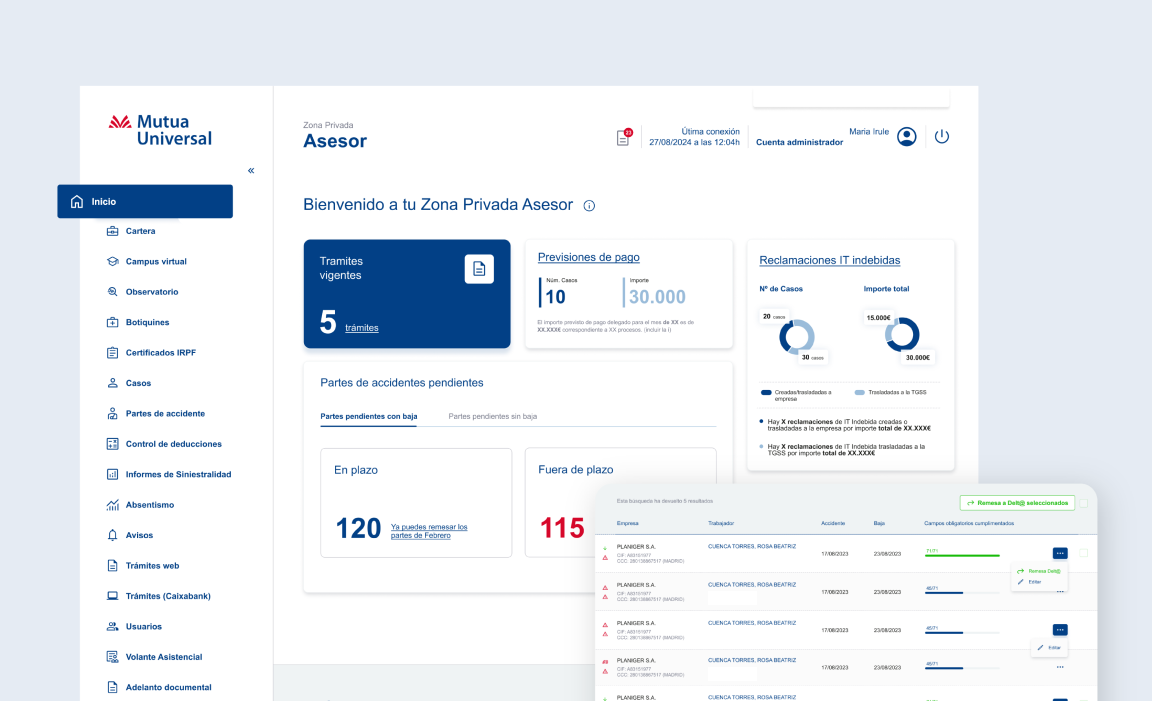Case study
Mutua Universal

Client
Mutua Universal
Services
Digital Experience & Innovation
Industry
Insurance
Context
Mutua Universal, founded in 1907, is a collaborating entity with Spain's Social Security, aiming to provide healthcare assistance and manage benefits arising from work-related accidents and occupational illnesses.


Mutua Universal in Numbers
To stay at the forefront of its sector, Mutua Universal has launched its 2021-2024 Strategic Plan, where digital transformation is one of the key pillars. The organization aims to enhance and optimize the UX of its digital platforms, both web and mobile applications, to provide its users (companies, workers, self-employed individuals, and advisors) with an accessible, agile, and secure digital environment for managing transactions and services.

Challenge
Mutua Universal faced the challenge of significantly improving the user experience (UX/UI) for all its stakeholders: companies, workers, self-employed individuals, and advisors. The growing need for more accessible, secure, and efficient digital services drove the organization to tackle the following key challenges:
Modernization
Mutua Universal had platforms that, while functional, required modernization in terms of usability, graphical interface, and accessibility. Existing digital tools such as the Private Patient Zone, Patient APP, and Advisor Portal needed a comprehensive update to align with current user expectations and meet the most advanced digital experience standards.
Design System
Existing design processes and platforms were fragmented, with a workflow that created integration and collaboration challenges between design and development teams. The need to implement a unified design system and adopt tools that enabled more efficient collaborative work was crucial for optimization.
Information Architecture
The use of the platforms was not fully optimized for Mutua Universal's specific user needs, especially for advisors and companies relying on the Advisor Portal to manage critical transactions. Non-intuitive interfaces and a lack of optimized information architecture hindered navigation and access to essential services.
Scalable System
The need to create a scalable and consistent system across different devices (desktop, tablet, mobile) also presented a challenge. Current interfaces were not optimized to function seamlessly.

Solution
To address Mutua Universal's challenges, SATEC, through its Creative Experience Design (CED) area, implemented a comprehensive solution focused on enhancing the user experience (UX/UI) and modernizing the mutual's digital platforms. This solution included a collaborative design approach, ongoing work with development teams, and the implementation of new tools and methodologies to optimize the organization's digital services.
The project began with a comprehensive evaluation of existing platforms, focusing on their usability, information architecture, and operational efficiency. The SATEC team conducted:

· A heuristic analysis of the tools most used by clients, highlighting the Advisor Portal, to identify areas for improvement.
· Interviews and surveys with end users (advisors and companies) to gather valuable insights on their needs, pain points, and expectations.
Results
The implementation of SATEC's comprehensive solution for Mutua Universal has generated significant results and continues to evolve as both teams collaborate on new developments and improvements.
User Satisfaction
The optimization of other digital services has significantly increased user satisfaction, as advisors and companies now find the platform more accessible and easier to use.
Smooth Navigation
Smooth navigation has enabled users to carry out procedures more efficiently, reducing the time needed to complete key tasks.
Responsive Design
The responsive design of the platforms has greatly improved service accessibility and increased platform usage across different environments, adapting to users' changing needs.
Process Optimization
In projects such as CUME and Delegation of Vote, significant improvements were achieved in optimizing specific processes, enhancing user experience and operational efficiency.
Training Sessions
The training sessions provided by SATEC have improved internal collaboration, fostering better process integration and greater agility in delivering new functionalities.
The adoption of Figma as a collaborative tool and the implementation of the Design System have enabled continuous improvements in operational efficiency. This has resulted in:
· Reduction in development times for new features.
· Greater visual and functional consistency, making platform updates and maintenance easier.
